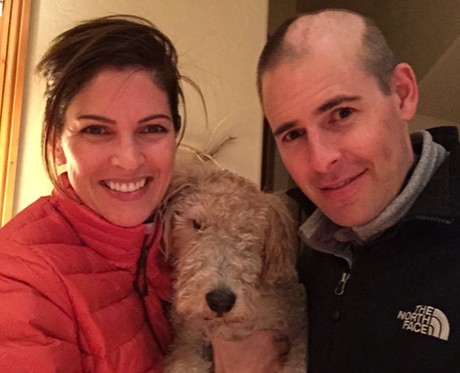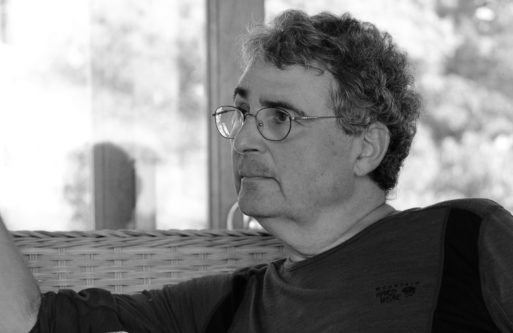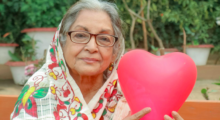Over the past several years, a number of states have enacted legislation legalizing medical aid in dying, or physician assisted death. The salient points in each of these laws are essentially the same. They allow terminally ill, mentally competent adults to end their lives by taking a lethal dose of medication prescribed by their physician. They also allow physicians to prescribe the medication with legal impunity. In each case, the goal of the law has been to give dying patients the means with which to end their suffering at a time of their choosing in a painless and nonviolent way.

Matt Larson has brain cancer, and campaigned in Colorado in support of the End of Life Options Act.
(Credit: coendoflifeoptions.org)
No doctor can be forced to participate in medical aid in dying. Yet, the debate among physicians about whether such laws are acceptable wages on. Two recent op-eds in the Duluth News Tribune highlight the huge chasm that exists between the two sides.
In the first article, published on Dec. 21, 2016, Minnesota physician Dr. Steven Bergeson argues that “physician assisted suicide” is not only unethical, but a threat to other forms of health care. He claims that “the certainty that I will do everything in my power to heal my patient and, in those cases where a cure is not possible, to comfort and walk alongside him or her,” is the basis of doctor-patient trust. And, he adds, “a doctor’s commitment to the patient should be unaffected by societal pressures, insurance companies and even the diagnosis itself.” He then cites the oft-quoted tenet of the Hippocratic oath, “First, do no harm.”
What’s more, Dr. Bergeson argues, aid-in-dying laws give insurance companies a new option for denying costly care. That is, they allow insurers to refuse to pay for expensive, life-extending treatments while simultaneously dangling the “carrot” of physician-assisted death. To support this claim, he cites a recent case of a young woman in California to whom this ostensibly occurred. (See note below.)
Lastly, Bergeson claims that physicians are abandoning their patients by helping them actualize their desire to die, no matter how strong or well-considered that desire might be. Quoting Mayo Clinic palliative care physician Dr. Coty Ingram, he writes, “People who at one moment voice the desire to die often later say how grateful they are to still be alive once their symptoms are under control.” Like Dr. Ingram, Bergeson believes that widely available palliative care and hospice would eliminate the need for patients to end their own lives.

Most people who choose aid in dying are already receiving hospice care
(Credit:thedenverhospice.org)
On the other side of the argument is Dr. Rebecca Thoman, campaign manager for Compassion & Choices’ Doctors for Dignity. Dr. Thoman penned an op-ed for the Duluth Tribune published on Jan. 12, 2017, writing with the same fervor as Dr. Bergeson. In it, she states her belief that “factually, legally, and medically speaking, it is inaccurate to equate medical aid in dying with assisted suicide.” She then goes on to refute Dr. Bergeson’s claims that legalized aid in dying compromises health care by citing a few facts:
*Insurance companies routinely deny payment for futile care, whether or not the option of medical aid in dying is available.
*Most patients (90 percent) who choose aid in dying are already under hospice care and have already stopped pursuing expensive, life-extending therapies.
*Medical aid-in-dying laws have not been shown to substantially reduce healthcare costs in the states where they are in effect.
She goes on to discuss the implications of the tenet “do no harm” in the context of today’s technologically advanced medical care, stating, “…physicians can now prolong and extend life almost indefinitely.” Yet we know that such unfettered use of medical technology causes a great deal of harm, particularly when it does nothing more than prolong an inevitable death. Instead of refusing to acknowledge this, she says, physicians should embrace the concept of “shared medical decision-making and fully informed, patient-centered care, especially in care at the end of life.”
Sadly, those who stand on the opposite sides of this ongoing debate are unlikely ever to agree. Physicians like Dr. Bergeson seem to believe that their ministrations ought to be sufficient to alleviate all suffering, even when their patients clearly indicate they are not. The fact that most people who choose aid in dying are already in hospice, getting the best end-of-life care available to them, is apparently not sufficient to shake that unwavering belief.
Doctors like Thoman believe just as strongly that patients have a right to autonomy, and physicians have a duty to listen and accept what the patient wants — or at least not stand in their way.

Dr. Roger Kligler
(Credit: Alicia Orsini via pbx.org)
Unfortunately, hundreds of dying patients are caught in this ethical quagmire — people like Dr. Roger Kligler, who has metastatic prostate cancer and is currently suing the state of Massachusetts for the right to die on his own terms. A long-time advocate of aid in dying, Kligler believes it is his and every patient’s right to define “unbearable suffering” in their own way. Writing about his decision to sue the state in a poignant article for Boston Magazine, he says that, after battling cancer and the side effects of cancer treatment for 15 years, death no longer frightens him. But, he adds:
“What does scare me… is the strong likelihood that I will spend my last days on Earth unable to do the normal things that make life enjoyable, losing my autonomy and dignity, being barely alive yet in severe pain, drifting in and out of a morphine-induced haze while my loved ones take shifts on a deathwatch. That is not how I want to die. Would you?”
Independent polls show that 70 percent of Americans support medical aid in dying. And doctors have the absolute right not to participate in the practice if it conflicts with their ethical, moral or religious beliefs. So, it seems to me that the medical profession ought to take their arguments to another forum, away from the public eye, and let the American people and those they elected to represent them make this choice.
Note: California’s End of Life Options Act specifically prohibits insurers from providing “any information in communications made to an individual about the availability of an aid-in-dying drug absent a request by the individual or his or her attending physician… Any communication shall not include both the denial of treatment and information as to the availability of aid-in-dying drug coverage.”
About Kathleen
Each month Kathleen Clohessy, R.N., offers a new perspective on living with a terminal illness. Kathleen comes to SevenPonds with 25 years experience as a registered nurse caring for families and children facing life-threatening illness. She began her career in the Pediatric Intensive Care Unit at Nassau County Medical Center in New York. After relocating to California, she spent 15 years as an R.N. and Assistant Nurse Manager at the Pediatric Oncology & Bone Marrow Transplant Unit at Lucille Salter Packard Children’s Hospital at Stanford. She uses her knowledge and expertise to enlighten our readers about the challenges associated with chronic illness and its effects on family relationships.

 Doctors Debate Medical Aid in Dying — Again
Doctors Debate Medical Aid in Dying — Again


 Having an Estate Plan Is Essential – So Is Discussing It With Your Children
Having an Estate Plan Is Essential – So Is Discussing It With Your Children
 The Healing Sound of Singing Bowls
The Healing Sound of Singing Bowls
 “Summons” by Aurora Levins Morales
“Summons” by Aurora Levins Morales














